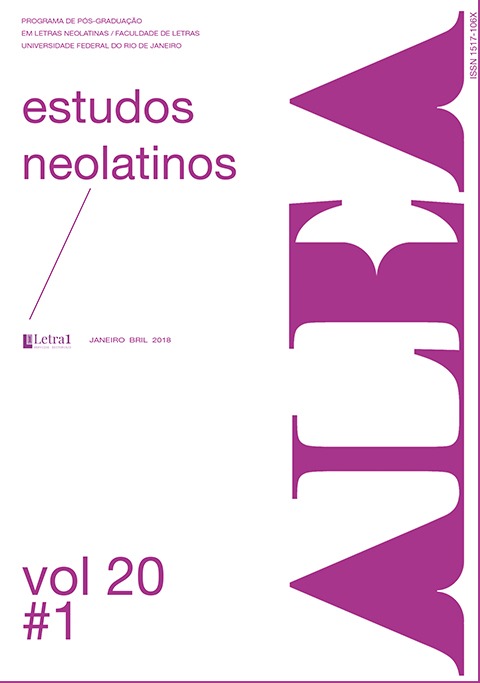The irrelevant mystery, the involuntary detective, the melting clue: notes on La pista de hielo, a neopolicial by Roberto Bolaño
DOI:
https://doi.org/10.1590/1517-106x/2018201125141Abstract
This article analyzes La pista de hielo (The Skating Rink, 1993), the third novel by Roberto Bolaño, as an exponent of the Ibero-American neopolicial, focusing on how two of the main dramatic elements of the detective tale, the enigma and the detective figure, are decentralized through a series of narrative mechanisms that eventually dismantle traditional genre conventions. Furthermore, we will link La pista de hielo and its narrative key elements with the rest of the novelistic of the Chilean author, as well as with the main exponents of the neopolicial, such as Paco Ignacio Taibo II, Leonardo Padura or Ramón Díaz Eterovic.
References
AGUILAR, Paula. Libros de arena, desiertos de horror: la narrativa de Roberto Bolaño.
Doctoral dissertation. National University of La Plata: La Plata, 2013.
BOLAÑO, Roberto. Estrella distante. Barcelona: Anagrama, 2013. BOLAÑO, Roberto. Entre paréntesis. Barcelona: Anagrama, 2012. BOLAÑO, Roberto. La pista de hielo, Barcelona: Anagrama, 2009. BOLAÑO, Roberto. 2666. Barcelona: Anagrama, 2009.
BOLAÑO, Roberto. Los detectives salvajes. Barcelona: Anagrama, 2007. BOLAÑO, Roberto. Monsieur Pain. Barcelona: Anagrama, 1999.
BOLAÑO, Roberto and PORTA, Antoni G. Consejos de un discípulo de Morrison a un fanático de Joyce. Diario de bar. Barcelona: Acantilado, 2006.
CASTELLANOS MOYA, Horacio. Baile con serpientes. Barcelona: Tusquets, 2012.
CASTELLANOS MOYA, Horacio. Insensatez. Barcelona: Tusquets, 2005.
CASTELLANOS MOYA, Horacio. Donde no estén ustedes. Barcelona: Tusquets, 2003.
CHANDLER, Raymond. The Notebooks of Raymond Chandler and English Summer.
A Gothic Romance. New York: fte Ecco Press, 1976.
CHRISTIE, Agatha. And Then There Were Nonce. 1939. New York: Harper, 2011.
COELLO GUTIÉRREZ, Emiliano. “La pista de hielo (1993) en el contexto de la nueva novela negra latinoamericana”. Mitologías hoy 7, 2013, p. 75-83.
DÍAZ ETEROVIC, Ramón. La ciudad está triste. Santiago de Chile: LOM, 2000. EPPLE, Juan Armando. “Leonado Padura Fuentes”. Hispamérica 71, 1995, p. 49-66.
FRANKEN KURZEN, Clemens A. Crimen y verdad en la novela policial chilena actual. Santiago de Chile: University of Santiago de Chile, 2013.
GARCÍA TALAVÁN, Paula. “La novela neopolicial latinoamericana: una revuelta ético-estética del género”. Cuadernos Americanos, v. 148, n.2, 2014, p. 63-85.
GARCÍA TALAVÁN, Paula. “Transgenericidad y cultura del desencanto: el neopolicial Ibero-Americano”. Letral 7, 2011, p. 49-58.
GIARDINELLI, Mempo. El género negro. City of Mexico: Autonomous Metropolitan University, 1996.
GIARDINELLI, Mempo. Qué solos se quedan los muertos. Barcelona: Plaza y Janés, 1986.
GOPEGUI, Belén. El padre de Blancanieves. Barcelona: Anagrama, 2007.
HERNÁNDEZ, Sonia and Puig, Marta. “Conclusión: una entrevista inédita. Entrañable huraño”. In: Paz Soldán, Edmundo y Faverón Patriau, Gustavo (eds.): Bolaño salvaje. Candaya: Barcelona, 2008, p. 475-478.
HERRALDE, Jorge. Para Roberto Bolaño. Medellin: Villegas Editores, 2007. LOBO, Tatiana. El corazón del silencio. San Jose: Norma, 2004.
MARTÍN ESCRIBÁ, Álex and SÁNCHEZ ZAPATERO, Javier. “Una mirada al neopolicial latinoamericano: Mempo Giardinelli, Leonardo Padura y Paco Ignacio Taibo II”. Anales de Literatura Hispanoamericana 36, 2007: 49-58.
MORA, Carmen de. “En torno a Los detectives salvajes”. América sin nombre 16, 2001: 171-180.
NICHOLS, William J. “A quemarropa con Manuel Vázquez Montalván y Paco Ignacio Taibo II”. Arizona Journal of Hispanic Cultural Studies 2, 1998: 197-232.
NOGUEROL JIMÉNEZ, Francisca. “Neopolicial latinoamericano: el triunfo del asesino”. Ciberletras. Revista de crítica literaria y de cultura 15, 2006.
PADURA FUENTES, Leonardo. “Modernidad y posmodernidad: la novela policial en Iberoamérica”. Hispamérica 84, 1999, p. 37-50.
PELLICER, Rosa. “Críticos detectives y críticos asesinos: la busca del manuscrito en la novela policíaca hispanoamericana (1990-2006)”. Anales de Literatura Hispanoamericana 36, 2007, p. 19-35.
PINO, Miriam. “Roberto Bolaño y las reelecturas de la novela negra: La pista de hielo”. Literatura y lingüística 1, Santiago de Chile, 2006: 117-128.
PINTO, Rodrigo. “La pista de hielo”. In: Manzoni, Celia (ed.): Roberto Bolaño. La escritura como tauromaquia. Buenos Aires: Corregidor, 2002, p. 133-143.
PLIMPTON, George. “Ernest Hemingway. fte art of fiction no. 21”. The Paris Review 18, 1958. http://www.theparisreview.org/interviews/4825/the-art-of- fiction-no-21-ernest-hemingway. Accessed on 06/02/14.
REY ROSA, Rodrigo. Que me maten si. Barcelona: Seix Barral, 1997.
ROSSO, Ezequiel de. “Una lectura conjetural. Roberto Bolaño y el relato policial”. In: Manzoni, Celia (ed.). Roberto Bolaño. La escritura como tauromaquia. Buenos Aires: Corregidor, 2002. p. 133-143.
SÁNCHEZ VELASCO, Irene. El neopolicial chileno de las últimas décadas: teoría y práctica de un género narrativo. Doctoral dissertation. Madrid: Autonomous University of Madrid, 2010.
STOLZMANN, Uwe. “Entrevista a Roberto Bolaño”. In: López Bernasocchi, Augusta and López de Abiada, José Manuel (eds.). Roberto Bolaño. Estrella cercana. Ensayos sobre su obra. Madrid: Verbum, 2012, p. 364-376.
TAIBO II, Pacio Ignacio. Todo Belascoarán. La serie completa de Héctor Belascoarán Shayne. México D.F.: Planeta, 2010.
TAIBO II, Pacio Ignacio. La vida misma, City of Mexico: Planeta, 1987. TRELLES PAZ, Diego. “Novela policial alternativa hispanoamericana (1960-2005)”. Aisthesis 40, 2006, p. 79-91.
VARAS, Patricia. “Belascoarán y Heredia: detectives postcoloniales”. Ciberletras 15, 2006. http://www.lehman.cuny.edu/ciberletras/v15/varas.html. Accessed on 04/19/2017.
Downloads
Published
Issue
Section
License
THE AUTHOR/S confirm/s his, her or their participation in all stages of work preparation: 1) Conception, project, bibliographical research, analysis and interpretation of data; 2) Writing and reviewing the manuscript; 3) Approval of the final version of the manuscript for publication; 4) Responsibility for all aspects of the work and guarantee for the accuracy and integrity of any part of the work. The submission of works implies the immediate cession, without onus, by all authors, of publication rights to the journal Alea, licensed under CC BY (https://creativecommons.org/licenses/by/4.0/). The authors are fully responsible for the content of the article and continue to hold all copyrights for subsequent publications of it, and should, if possible, include the reference to the first publication in the journal. Alea does not commit to returning received contributions. Authors of articles, reviews or translations will receive a copy of the journal.

